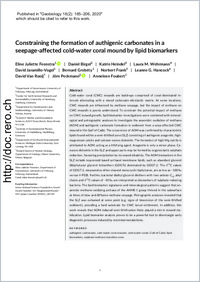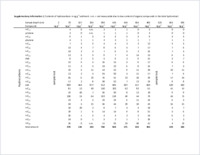Constraining the formation of authigenic carbonates in a seepage-affected cold-water coral mound by lipid biomarkers
- Feenstra, Eline Juliette Department of Geosciences University of Fribourg Fribourg Switzerland
- Birgel, Daniel Center for Earth System Research and Sustainability University of Hamburg Hamburg Germany
- Heindel, Katrin Department for Geodynamics and Sedimentology University of Vienna Vienna Austria
- Wehrmann, Laura M. School of Marine and Atmospheric Sciences SUNY Stony Brook Stony Brook NY USA
- Jaramillo‐Vogel, David Department of Geosciences University of Fribourg Fribourg Switzerland
- Grobéty, Bernard Department of Geosciences University of Fribourg Fribourg Switzerland
- Frank, Norbert Institute of Environmental Physics University of Heidelberg Heidelberg Germany
- Hancock, Leanne G. Department of Earth and Environmental Sciences Michigan State University East Lansing MI USA
- Van Rooij, David Renard Centre of Marine Geology Department of Geology Ghent University Ghent Belgium
- Peckmann, Jörn Center for Earth System Research and Sustainability University of Hamburg Hamburg Germany
- Foubert, Anneleen Department of Geosciences University of Fribourg Fribourg Switzerland
- 03.02.2020
Published in:
- Geobiology. - 2020, vol. 18, no. 2, p. 185–206
English
Cold‐water coral (CWC) mounds are build‐ups comprised of coral‐dominated intervals alternating with a mixed carbonate‐siliciclastic matrix. At some locations, CWC mounds are influenced by methane seepage, but the impact of methane on CWC mounds is poorly understood. To constrain the potential impact of methane on CWC mound growth, lipid biomarker investigations were combined with mineralogical and petrographic analyses to investigate the anaerobic oxidation of methane (AOM) and authigenic carbonate formation in sediment from a seep‐affected CWC mound in the Gulf of Cadiz. The occurrence of AOM was confirmed by characteristic lipids found within a semi‐lithified zone (SLZ) consisting of authigenic aragonite, high‐magnesium calcite and calcium‐excess dolomite. The formation of high‐Mg calcite is attributed to AOM, acting as a lithifying agent. Aragonite is only a minor phase. Ca‐excess dolomite in the SLZ and upper parts may be formed by organoclastic sulphate reduction, favouring precipitation by increased alkalinity. The AOM biomarkers in the SLZ include isoprenoid‐based archaeal membrane lipids, such as abundant glycerol dibiphytanyl glycerol tetraethers (GDGTs) dominated by GDGT‐2. The δ13C values of GDGT‐2, measured as ether‐cleaved monocyclic biphytanes, are as low as −100‰ versus V‐PDB. Further, bacterial dialkyl glycerol diethers with two anteiso‐C15 alkyl chains and δ13C values of −81‰ are interpreted as biomarkers of sulphate‐reducing bacteria. The lipid biomarker signatures and mineralogical patterns suggest that anaerobic methane‐oxidizing archaea of the ANME‐1 group thrived in the subsurface at times of slow and diffusive methane seepage. Petrographic analyses revealed that the SLZ was exhumed at some point (e.g. signs of bioerosion of the semi‐lithified sediment), providing a hard substrate for CWC larval settlement. In addition, this work reveals that AOM‐induced semi‐lithification likely played a role in mound stabilization. Lipid biomarker analysis proves to be a powerful tool to disentangle early diagenetic processes induced by microbial metabolisms.
- Faculty
- Faculté des sciences et de médecine
- Department
- Département de Géosciences
- Language
-
- English
- Classification
- Geology
- License
-
License undefined
- Identifiers
-
- RERO DOC 328195
- DOI 10.1111/gbi.12373
- Persistent URL
- https://folia.unifr.ch/unifr/documents/308658
Other files
Statistics
Document views: 159
File downloads:
- pdf: 244
- Supplementary material: 146

